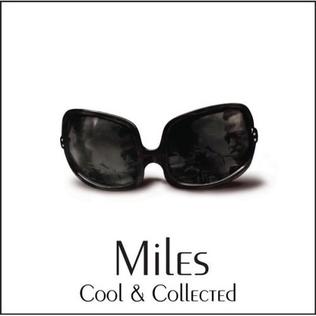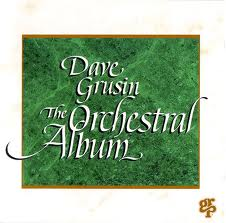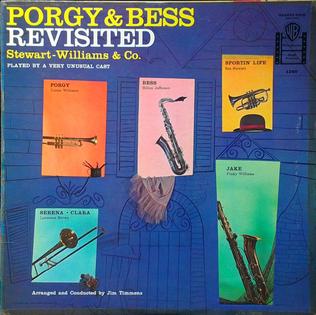Related Research Articles

Rhapsody in Blue is a 1924 musical composition written by George Gershwin for solo piano and jazz band, which combines elements of classical music with jazz-influenced effects. Commissioned by bandleader Paul Whiteman, the work premiered in a concert titled "An Experiment in Modern Music" on February 12, 1924, in Aeolian Hall, New York City. Whiteman's band performed the rhapsody with Gershwin playing the piano. Whiteman's arranger Ferde Grofé orchestrated the rhapsody several times including the 1924 original scoring, the 1926 pit orchestra scoring, and the 1942 symphonic scoring.

Porgy and Bess is an English-language opera by American composer George Gershwin, with a libretto written by author DuBose Heyward and lyricist Ira Gershwin. It was adapted from Dorothy Heyward and DuBose Heyward's play Porgy, itself an adaptation of DuBose Heyward's 1925 novel Porgy.

The alto saxophone is a member of the saxophone family of woodwind instruments. Saxophones were invented by Belgian instrument designer Adolphe Sax in the 1840s and patented in 1846. The alto saxophone is pitched in the key of E♭, smaller than the B♭ tenor but larger than the B♭ soprano. It is the most common saxophone and is used in popular music, concert bands, chamber music, solo repertoire, military bands, marching bands, pep bands, carnatic music, and jazz.

Robert Russell Bennett was an American composer and arranger, best known for his orchestration of many well-known Broadway and Hollywood musicals by other composers such as Irving Berlin, George Gershwin, Jerome Kern, Cole Porter, and Richard Rodgers.

This 1956 recording based on George Gershwin's opera Porgy and Bess was the second "complete" recording of the opera after the 1951 version, and the first recording of the work to feature jazz singers and musicians instead of operatic singers and a classical orchestra.

Porgy and Bess is a studio album by jazz vocalist and trumpeter Louis Armstrong and singer Ella Fitzgerald, released on Verve Records in 1959. The third and final of the pair's albums for the label, it is a suite of selections from the George Gershwin opera Porgy and Bess. Orchestral arrangements are by Russell Garcia, who had previously arranged the 1956 jazz vocal recording The Complete Porgy and Bess.

Porgy and Bess is a studio album by the jazz musician Miles Davis, released in March 1959 on Columbia Records. The album features arrangements by Davis and collaborator Gil Evans from George Gershwin's 1935 opera of the same name. The album was recorded in four sessions on July 22, July 29, August 4, and August 18, 1958, at Columbia's 30th Street Studio in New York City. It is the second collaboration between Davis and Evans and has garnered much critical acclaim since its release, being acknowledged by some music critics as the best of their collaborations. Jazz critics have regarded the album as historically important.
Porgy and Bess, the opera by George Gershwin, has been recorded by a variety of artists since it was completed in 1935, including renditions by jazz instrumentalists and vocalists, in addition to operatic treatments.
Catfish Row, originally titled Suite from Porgy and Bess, is an orchestral work by George Gershwin based upon music from his famous opera Porgy and Bess. Gershwin completed the work in 1936 and it premiered at the Academy of Music in Philadelphia on January 21 of that year, with Alexander Smallens conducting the Philadelphia Orchestra. Gershwin played the piano part, including the piano solo in the opening moments. This piece preserves some of the darkest and most complex music Gershwin ever wrote.

Symphonic Dances, Op. 45, is an orchestral suite in three movements completed in October 1940 by Russian composer Sergei Rachmaninoff. It is his final major composition, and his only piece written in its entirety while living in the United States.
"I Loves You, Porgy" is a duet from the 1935 opera Porgy and Bess with music by George Gershwin and lyrics by Ira Gershwin. It was performed in the opera's premiere in 1935 and on Broadway the same year by Anne Brown and Todd Duncan. They recorded the song on volume 2 of the album Selections from George Gershwin's Folk Opera Porgy and Bess in 1942. The duet occurs in act 2, scene 3, Catfish Row, where Porgy promises Bess that he will protect her. Bess has a lover, Crown, who is abusive and continually seduces her.
This is a complete list of recordings by the Los Angeles Philharmonic, shown alphabetically by conductor, and then by recording label.

Porgy & Bess is a 1997 album by the jazz saxophonist Joe Henderson, released on Verve Records. It contains Henderson's arrangements of music from George Gershwin's opera Porgy and Bess. It was his final album as a leader.

Super Hits is a greatest hits album from Miles Davis. Released in 2001, it reached #22 on Billboard's Jazz Albums chart.

Cool & Collected is a compilation album by American jazz musician Miles Davis, released in 2006 by Columbia Records and recorded from 1955 through 1984.

Porgy & Bess is an album by American jazz guitarist Mundell Lowe and his All Stars featuring their interpretations of the George Gershwin folk opera Porgy and Bess recorded in 1958 for the RCA Camden label.

The Orchestral Album is an album by American pianist Dave Grusin released in 1994, recorded for GRP Records. It contains both original recordings and new arrangements of previously released material. The arrangement of Three Cowboy Songs won the 1995 Grammy Award for Best Instrumental Arrangement.
Mothership is a single-movement composition for orchestra and electronica by the American composer Mason Bates. The piece received its world premiere March 20, 2011 at the Sydney Opera House by the YouTube Symphony Orchestra under Michael Tilson Thomas, with featured improvisatorial soloists Paulo Calligopoulos on electric guitar, Ali Bello on violin, Su Chang on zheng, and John Burgess on bass guitar. The premiere was broadcast live on YouTube and garnered nearly two million viewers.

Porgy & Bess Revisited, subtitled Played by a Very Unusual Cast, is an album of jazz interpretations of songs from the George Gershwin opera Porgy and Bess performed by cornetist Rex Stewart and trumpeter Cootie Williams, with saxophonists Hilton Jefferson and Pinky Williams and trombonist Lawrence Brown, that was recorded in late 1958 and released on the Warner Bros. label.
References
- Bennett's program note for the March 1943 Pittsburgh Symphony premiere
- Bennett, Robert Russell. The Broadway Sound: The Autobiography and Selected Essays of Robert Russell Bennett. Ed. George J. Ferencz, University of Rochester Press, 1999 (Eastman Studies in Music 12)
- Ferencz, George J. “Porgy and Bess on the Concert Stage: Gershwin's 1936 Suite (“Catfish Row”) and the 1942 Gershwin–Bennett Symphonic Picture.” Musical Quarterly 94:1-2 (Spring-Summer 2011), 93-155.